Comparative Study on Heat Dissipation Performance of Pure Immersion and Immersion Jet Liquid Cooling System for Single Server
Abstract
:1. Introduction
2. Single Server Liquid Cooling Test Bench and Experimental Method
2.1. Immersion Jet Liquid Cooling Test Bench
2.1.1. Immersion Part Design
2.1.2. Jet Part Design
2.2. Experimental Method and Instrument Parameters
2.2.1. Experimental Procedure
- The ambient temperature of the laboratory was controlled at 28 ± 2 °C, and the humidity was maintained at 40 ± 5% RH. There was no significant external heat or cold source interference.
- A liquid-cooled test bench was constructed with installed pipeline systems and instrument accessories. Heating loads were positioned on the inner wall of the liquid-cooled cabinet, and a dedicated temperature controller was connected to regulate the heating plate’s temperature.
- The heating load was heated to 60 °C by the temperature controller, and the inlet water temperature of the coolant was set and adjusted using a low constant temperature water bath (18 °C, 22 °C, 27 °C). The jet distance (10 cm, 5 cm, 3 cm, 1 cm) and the inlet water flow rate (8 L/min, 13 L/min, 18 L/min) were adjusted according to the experimental design requirements.
- The experiment was initiated, and the surface temperature changes in the heating load were continuously monitored. The experiment continued until the heating load’s surface temperature achieved a steady state, defined as a temperature fluctuation within the ±0.5 °C error margin, indicating that thermal equilibrium had been attained within the system.
- Once the heating load surface temperature stabilized, the outlet temperature of the coolant, along with the temperatures at the upper, middle, and lower levels of the liquid cooler, were recorded.
- To ensure the reliability and repeatability of the experimental results, each experimental condition was repeated three times. Each experiment was performed according to the above steps, and the data were recorded separately. To reduce the influence of random error, the arithmetic mean of the corresponding temperature readings from the three experiments was taken.
- Based on the collected data, the heat dissipation capability of the immersion jet liquid cooling system was evaluated against that of the pure immersion liquid cooling system. Specific parameters such as jet distance and flow rate were evaluated to ascertain their respective impacts on system heat dissipation efficiency.
2.2.2. Laboratory Apparatus
2.3. Error Analysis
3. Experimental Results and Analysis
3.1. Experimental Results of Immersion Liquid Cooling System
3.2. Experimental Results of Immersion Jet Liquid Cooling System
3.2.1. Comparison of Heat Dissipation Effect of Different Jet Distance
3.2.2. Comparison of Heat Dissipation Effect at Different Inlet Water Flow Rates
4. Model Dimensionless Analysis
5. Conclusions
- In the immersion liquid cooling system, reducing the inlet temperature from 27.0 °C to 18.0 °C can decrease the server’s surface stable temperature by 6.4 °C and enhance the steady-state surface heat transfer coefficient by 107.7 W/(m2·K). However, this also augments the temperature disparity between the inlet and outlet water, concurrently amplifying the internal temperature gradient of the liquid cooler by approximately 3.7 °C. To balance heat dissipation efficiency with the system’s heat load, an inlet water temperature of 22 °C was chosen. At this temperature setting, the inlet–outlet temperature difference was 6.9 °C, the internal temperature gradient was 6.5 °C, and the surface heat transfer coefficient remained stable at 891.9 W/(m2·K).
- The immersion jet liquid cooling system improves the mixing and disturbance of the coolant inside the cooler through the jet effect, achieving a more uniform temperature distribution and higher heat-carrying capacity. Compared with the pure immersion system, the surface temperature of the heating load is reduced from 43.8 °C to 30.3 °C, and the steady-state surface heat transfer coefficient is increased by 2.6 times to about 2342.7 W/(m2·K).
- When the jet distance decreases from 10 cm to 1 cm, the surface temperature of the heating load in the immersion jet liquid cooling system decreases by 2.7 °C, and the steady-state surface heat transfer coefficient increases by 467.3 W/(m2·K). However, the inlet–outlet temperature difference increases slightly. Compared with a jet distance of 1 cm, when the jet distance is adjusted to 3 cm, the backflow interference effect between the fluids is significantly mitigated, the system’s heat transfer capacity is enhanced by 107.7 W/(m2·K), and the temperature difference between the inlet and outlet water is lowered by 0.7 °C.
- Under the premise of an inlet water temperature of 22 °C and a jet distance of 3 cm, increasing the inlet water flow rate can reduce the temperature difference between the inlet and outlet and achieve a more even temperature distribution inside the liquid cooler. Raising the flow rate from 8 L/min to 18 L/min effectively lowers the surface temperature of the heating load from 35.0 °C to 28.0 °C while also increasing the steady-state surface heat transfer coefficient from 1495.7 W/(m2·K) to 3136.2 W/(m2·K).
- The immersion jet liquid cooling system model was simplified through dimensional analysis, and a dimensionless relationship was established. By fitting the experimental data using the nonlinear least squares method, a heat transfer correlation with an error of no more than 18% was obtained. The analysis shows that the inlet temperature is the dominant factor, the flow rate has a positive effect, and the jet distance has a limited effect, providing guidance for system optimization.
6. Patents
- Invention name: An immersion jet cooling device and method for data center server heat dissipation.
- 2.
- Invention Name: Immersion Jet Cooling Device and Method for Data Room Using Natural Cold Source Pre-cooled Fluorinated Liquid.
- 3.
- Invention name: A hierarchical cooling system and method for data center coupled with row-level air conditioning and immersion jet liquid cooling cabinet.
Author Contributions
Funding
Data Availability Statement
Conflicts of Interest
References
- Sharma, M.; Arunachalam, K.; Sharma, D. Analyzing the data center efficiency by using PUE to make data centers more energy efficient by reducing the electrical consumption and exploring new strategies. Procedia Comput. Sci. 2015, 48, 142–148. [Google Scholar] [CrossRef]
- Wang, Z.-Y.; Cai, H.-G.; Li, B. Blue Book of Data Center Development in China; Publishing House of Electronics Industry: Beijing, China, 2021. [Google Scholar]
- Chen, H.-W.; Dong, L. Current status and challenges for liquid-cooled data centers. Front. Energy Res. 2022, 10, 952680. [Google Scholar] [CrossRef]
- Azarifar, M.; Arik, M.; Chang, J.-Y. Liquid cooling of data centers: A necessity facing challenges. Appl. Therm. Eng. 2022, 247, 123112. [Google Scholar] [CrossRef]
- Wolf, D.; Viskanta, R.; Incropera, F. Turbulence dissipation in a free-surface jet of water and its effect on local impingement heat transfer from a heated surface: Part 1—Flow structure. J. Heat Transf. 1995, 117, 85–94. [Google Scholar] [CrossRef]
- Maddox, J.F.; Knight, R.W.; Bhavnani, S.H. Local thermal measurements of a confined array of impinging liquid jets for power electronics cooling. In Proceedings of the 2015 31st Thermal Measurement, Modeling & Management Symposium (SEMI-THERM), San Jose, CA, USA, 15–19 March 2015. [Google Scholar]
- Birbarah, P.; Gebrael, T.; Foulkes, T.; Stillwell, A.; Moore, A.; Pilawa-Podgurski, R.; Miljkovic, N. Water immersion cooling of high power density electronics. Int. J. Heat Mass Transf. 2020, 147, 118918. [Google Scholar] [CrossRef]
- Li, X.; Huang, Q.; Deng, J.; Zhang, G.; Zhong, Z.; He, F. Evaluation of lithium battery thermal management using sealant made of boron nitride and silicone. J. Power Sources 2020, 451, 227820. [Google Scholar] [CrossRef]
- Jithin, K.V.; Rajesh, P.K. Numerical analysis of single-phase liquid immersion cooling for lithium-ion battery thermal management using different dielectric fluids. Int. J. Heat Mass Transf. 2022, 188, 122608. [Google Scholar] [CrossRef]
- Robinson, A.J.; Schnitzler, E. An experimental investigation of free and submerged miniature liquid jet array impingement heat transfer. Exp. Therm. Fluid Sci. 2007, 32, 1–13. [Google Scholar] [CrossRef]
- Sung, M.K.; Mudawar, I. Single-phase hybrid micro-channel/micro-jet impingement cooling. Int. J. Heat Mass Transf. 2008, 51, 4342–4352. [Google Scholar] [CrossRef]
- Barrau, J.; Chemisana, D.; Rosell, J.; Tadrist, L.; Ibáñez, M. An experimental study of a new hybrid jet impingement/micro-channel cooling scheme. Appl. Therm. Eng. 2010, 30, 2058–2066. [Google Scholar] [CrossRef]
- Fan, S.; Duan, F. A review of two-phase submerged boiling in thermal management of electronic cooling. Int. J. Heat Mass Transf. 2020, 150, 119324. [Google Scholar] [CrossRef]
- Fan, S.; Duan, F. Correlations for heat transfer characteristics of the onset of nucleate boiling in submerged jet impingement. Int. J. Therm. Sci. 2021, 170, 107071. [Google Scholar] [CrossRef]
- Pambudi, N.A.; Sarifudin, A.; Firdaus, R.A.; Ulfa, D.K.; Gandidi, I.M.; Romadhon, R. The immersion cooling technology: Current and future development in energy saving. Alex. Eng. J. 2022, 61, 9509–9527. [Google Scholar] [CrossRef]
- Kline, S.J.; Mcclintock, F.A. Describing uncertainties in single-sample experiments. Mech. Eng. 1953, 75, 3–7. [Google Scholar]
- Liu, T.-M. Research and implementation of server temperature control system. Master’s Thesis, Xidian University, Xi’an, China, 2022. [Google Scholar]
- Oró, E.; Allepuz, R.; Martorell, I.; Salom, J. Design and economic analysis of liquid cooled data centres for waste heat recovery: A case study for an indoor swimming pool. Sustain. Cities Soc. 2018, 36, 185–203. [Google Scholar] [CrossRef]
- Carbó, A.; Oró, E.; Salom, J.; Canuto, M.; Macías, M.; Guitart, J. Experimental and numerical analysis for potential heat reuse in liquid cooled data centres. Energy Convers. Manag. 2016, 112, 135–145. [Google Scholar] [CrossRef]
- He, Z.-Q.; Yan, Y.-F.; Zhang, Z.-E. Thermal management and temperature uniformity enhancement of electronic devices by micro heat sinks: A review. Energy 2021, 216, 119223. [Google Scholar] [CrossRef]
- Hammoud, A.H.; Khalil, M.F. Characteristics of centrifugal pump handling stable oil-in-water emulsions. Editor. Advis. Boarde 2006, 15, 159–168. [Google Scholar]
- Wang, X.-Y. Fundamentals of Gas Dynamics; Northwestern Polytechnical University Press: Xi’an, China, 2006. [Google Scholar]
- Yang, S.-M.; Tao, W.-Q. Heat Transfer, 4th ed.; Higher Education Press: Beijing, China, 2006. [Google Scholar]

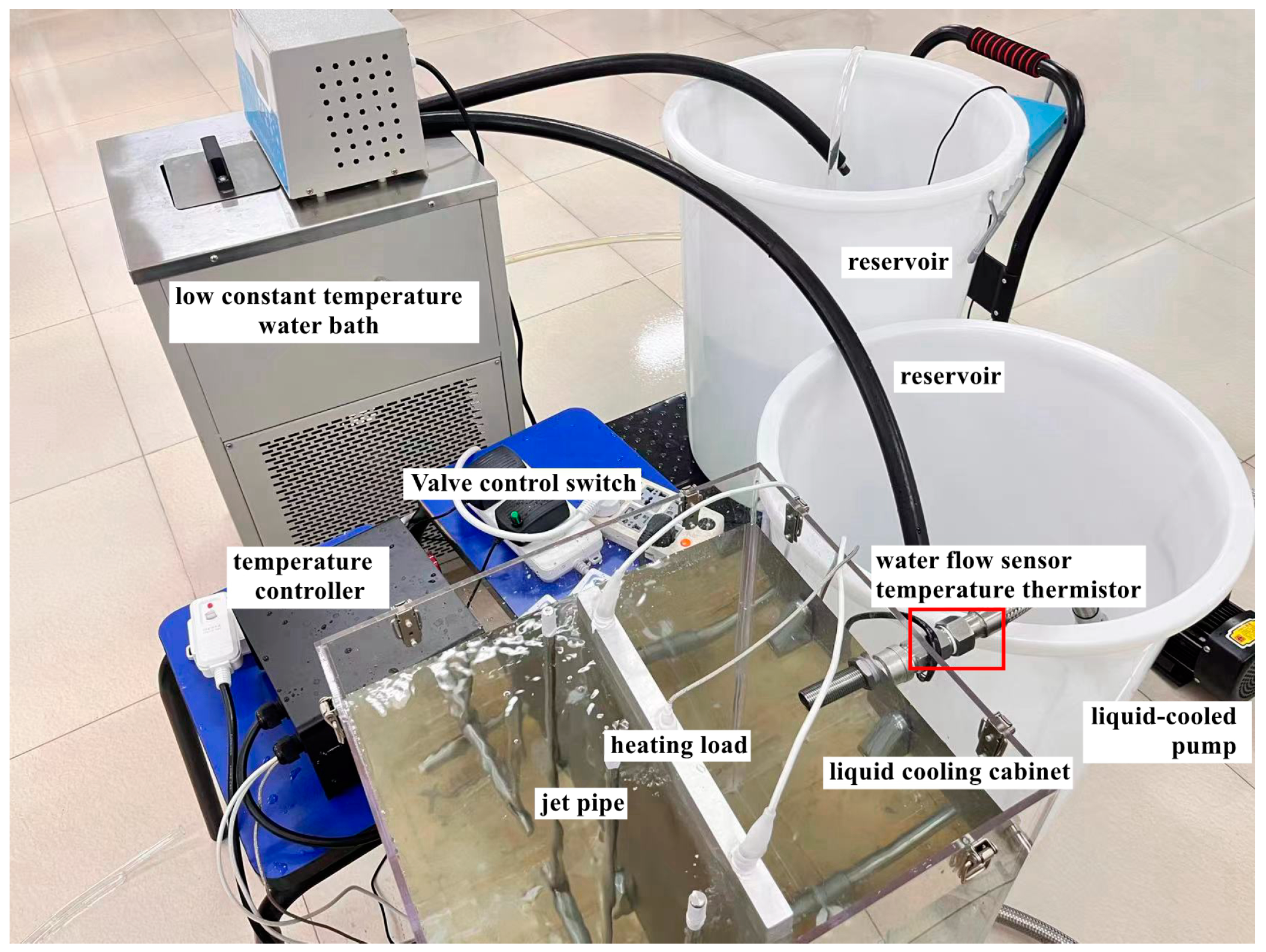


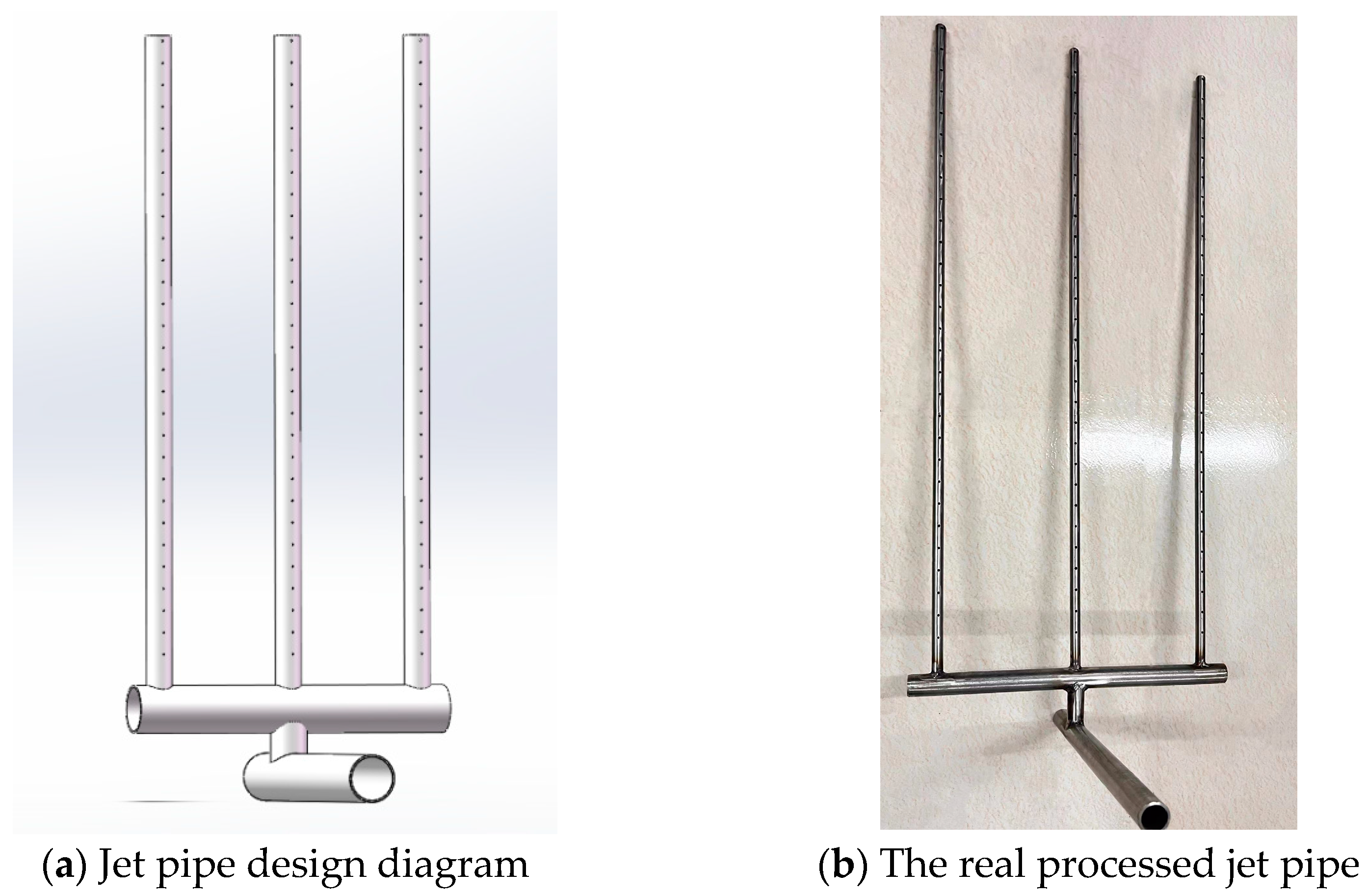

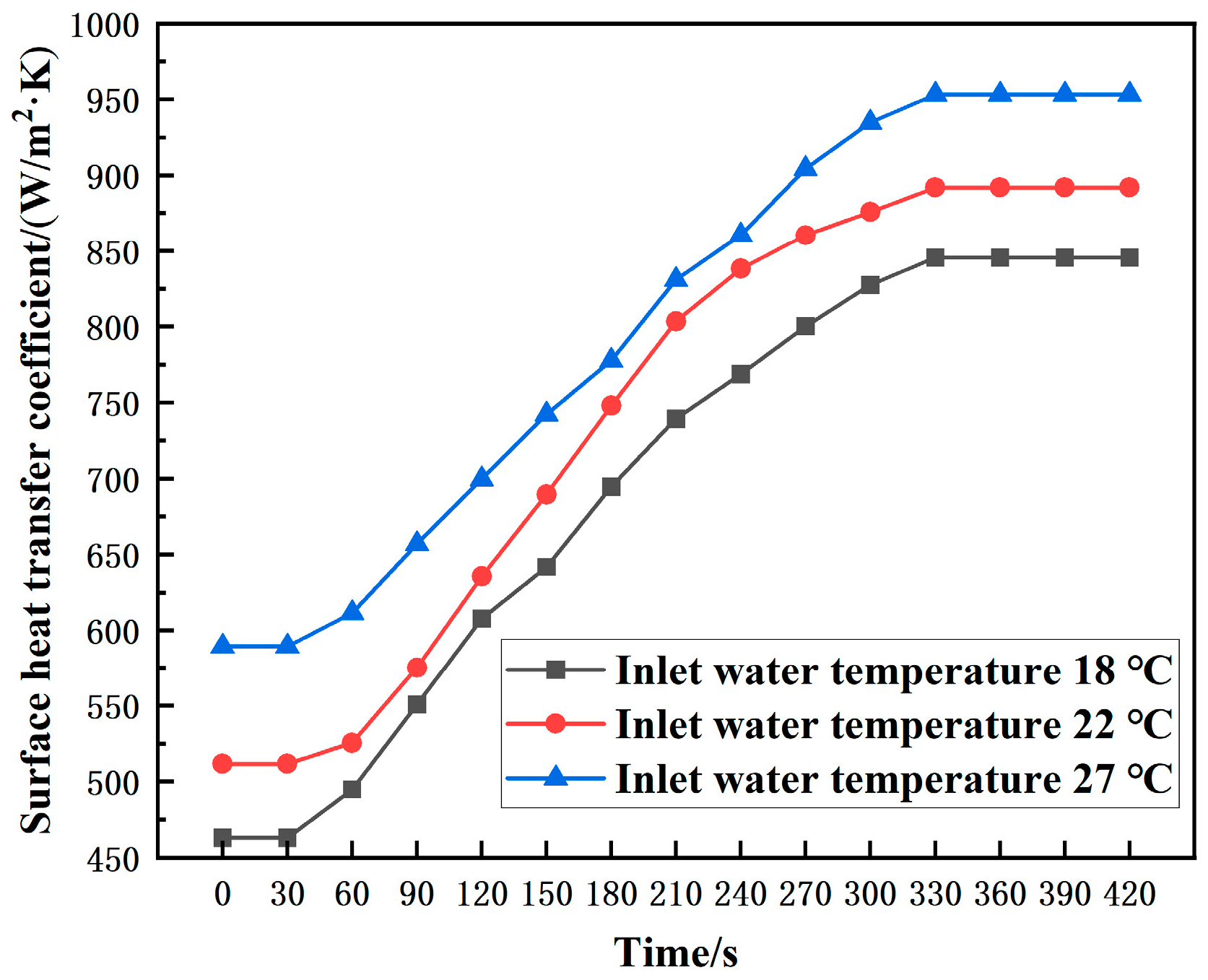


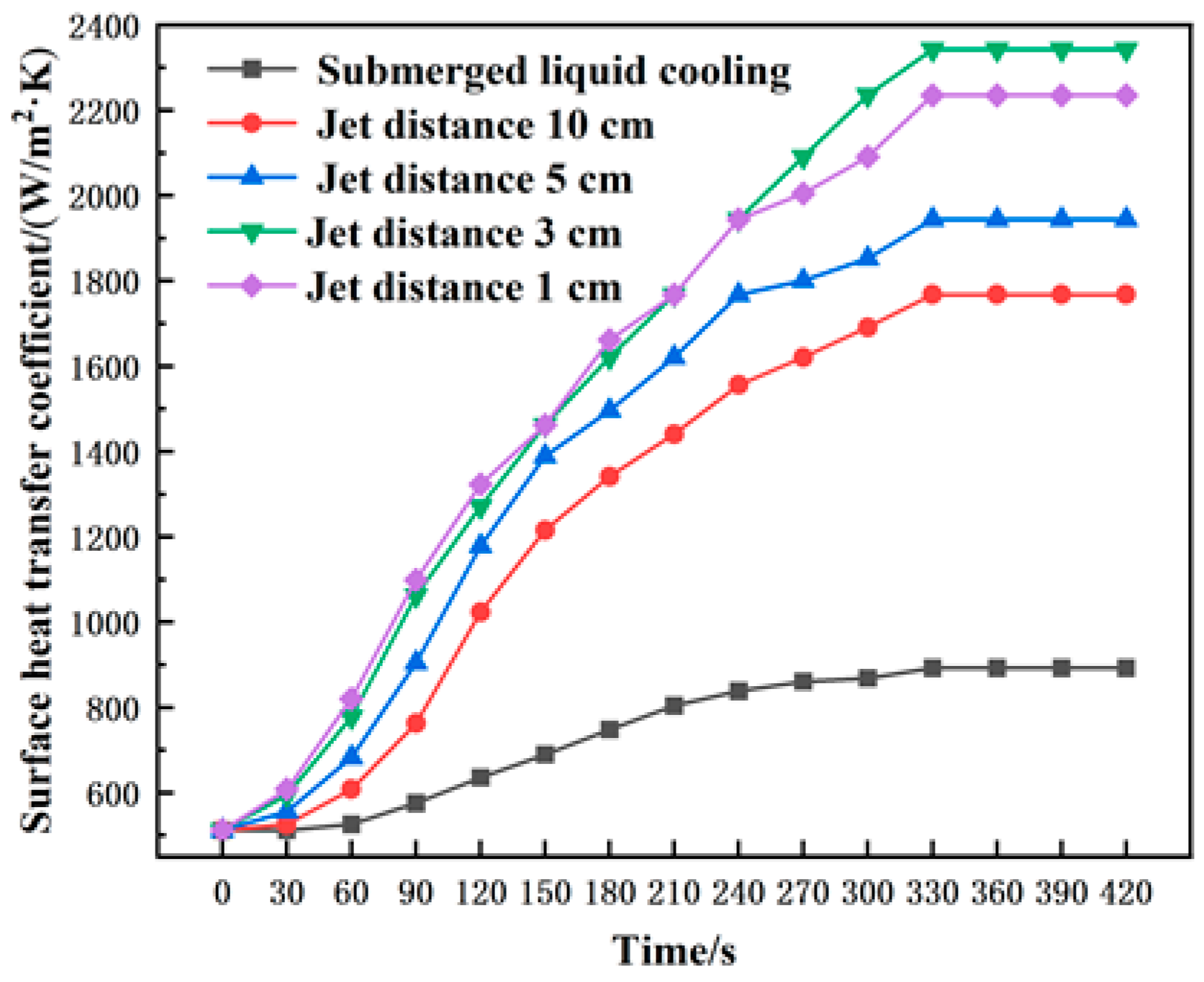
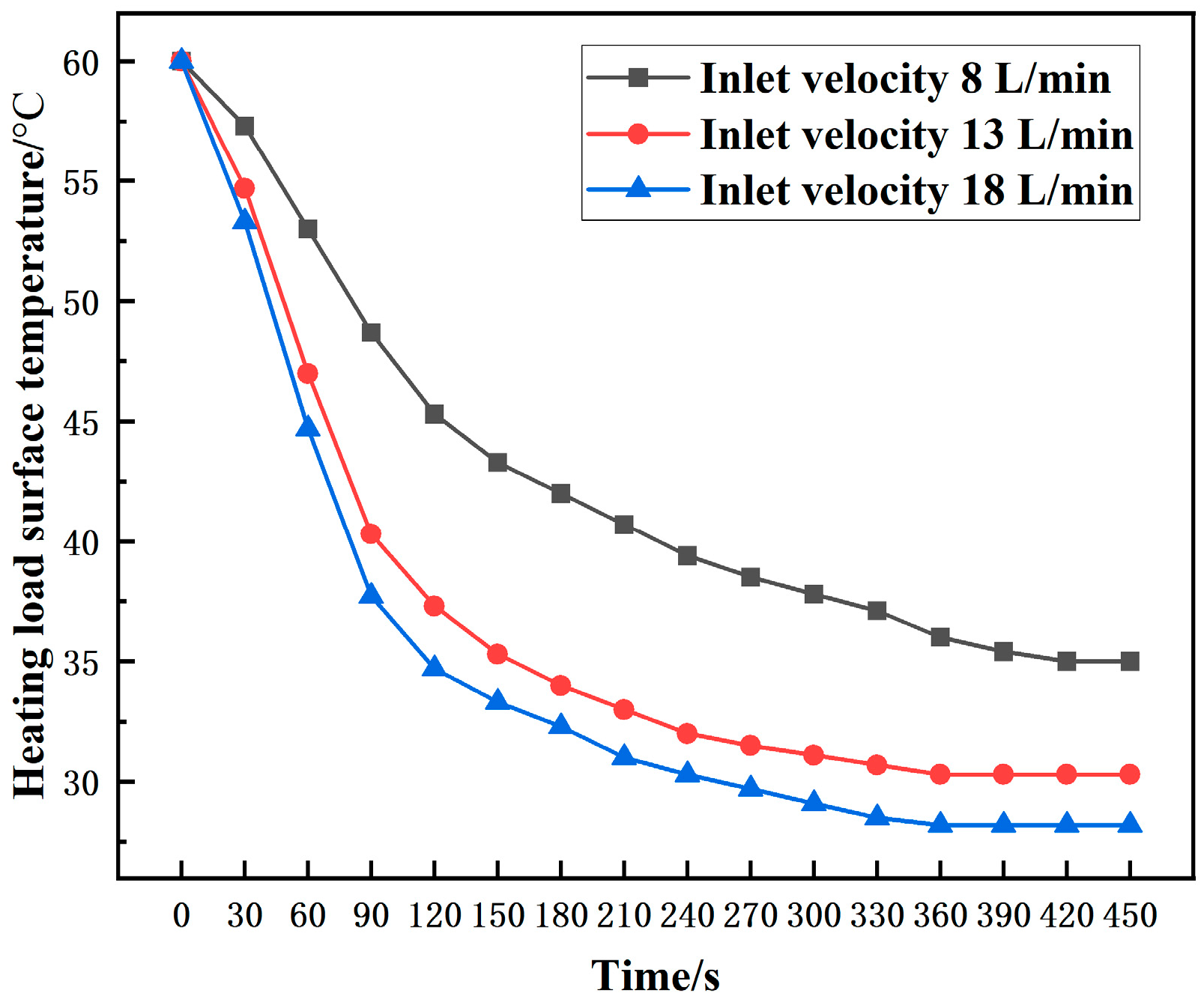
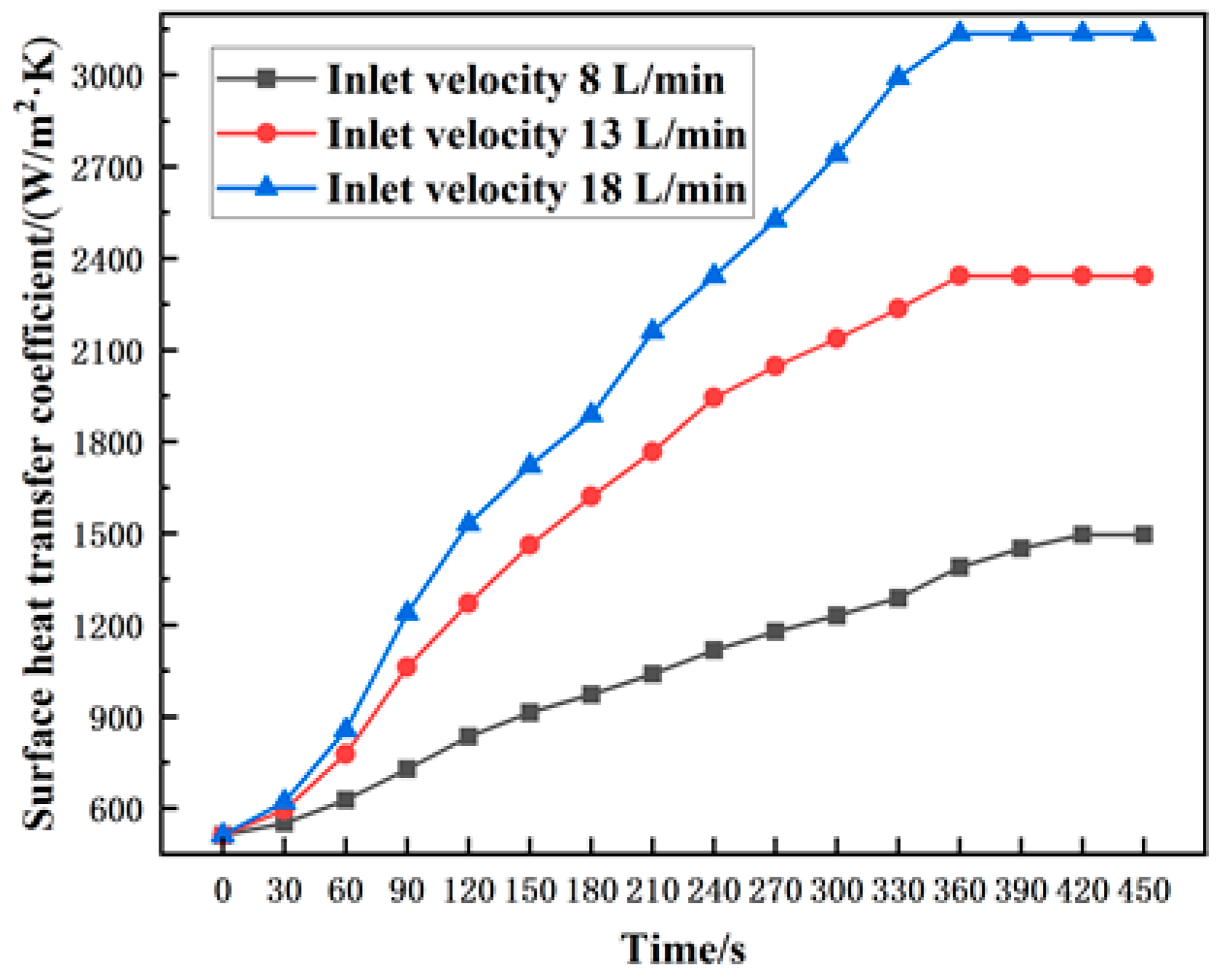

| Test Condition | Load Heating Temperature (°C) | Inlet Water Temperature (°C) | Jet Flow Rate (L/min) | Jet Distance (cm) |
|---|---|---|---|---|
| Condition A | 60 | 22 | 13 | 10/5/3/1 |
| Condition B | 60 | 22 | 8/13/18 | 3 |
| Instrument Name | Type-Specification | Range Ability |
|---|---|---|
| Self-priming pump | 25WBZ3-8-0.25 | flow rate 3 m3/h, head 8 m, electric power 0.37 kW |
| Cut-off valve | J11W | |
| Low constant temperature water bath | DC-0530 | −5~100 °C |
| Water flow sensor | flow rate 1~30 L/min | |
| Temperature thermistor | K-type | 0~600 °C |
| Digital thermometer | CX-WDJ200C | −50~200 °C |
| Inlet Water Temperature (°C) | Inlet Velocity (L/min) | Outlet Water Temperature (°C) | Water Temperature Difference (°C) | Coolant Temperature inside Liquid Cooler (°C) | |||
|---|---|---|---|---|---|---|---|
| Upper | Middle | Bottom | Temperature Difference | ||||
| 18.0 | 13 | 27.0 | 9 | 28.2 | 19.6 | 18.9 | 9.3 |
| 22.0 | 13 | 28.9 | 6.9 | 29.1 | 23.9 | 22.6 | 6.5 |
| 27.0 | 13 | 32.3 | 5.3 | 32.7 | 28.0 | 27.2 | 5.5 |
| Inlet Water Temperature (°C) | Inlet Velocity (L/min) | Jet Distance (cm) | Outlet Water Temperature (°C) | Water Temperature Difference (°C) | Coolant Temperature inside Liquid Cooler (°C) | |||
|---|---|---|---|---|---|---|---|---|
| Upper | Middle | Bottom | Temperature Difference | |||||
| 22.0 | 13 | 10 | 27.8 | 5.8 | 28.0 | 26.5 | 24.9 | 3.1 |
| 22.0 | 13 | 5 | 28.6 | 6.6 | 28.0 | 26.3 | 24.2 | 3.8 |
| 22.0 | 13 | 3 | 28.9 | 6.9 | 27.9 | 26.0 | 24.0 | 3.9 |
| 22.0 | 13 | 1 | 29.6 | 7.6 | 27.9 | 26.3 | 23.8 | 4.1 |
| Inlet Water Temperature (°C) | Jet Distance (cm) | Inlet Velocity (L/min) | Outlet Water Temperature (°C) | Water Temperature Difference (°C) | Coolant Temperature inside Liquid Cooler (°C) | |||
|---|---|---|---|---|---|---|---|---|
| Upper | Middle | Bottom | Temperature Difference | |||||
| 22.0 | 3 | 8 | 30.8 | 8.8 | 29.7 | 27.4 | 24.2 | 5.5 |
| 22.0 | 3 | 13 | 28.9 | 6.9 | 27.9 | 26.0 | 24.0 | 3.9 |
| 22.0 | 3 | 18 | 28.3 | 6.3 | 27.4 | 25.6 | 23.8 | 3.6 |
Disclaimer/Publisher’s Note: The statements, opinions and data contained in all publications are solely those of the individual author(s) and contributor(s) and not of MDPI and/or the editor(s). MDPI and/or the editor(s) disclaim responsibility for any injury to people or property resulting from any ideas, methods, instructions or products referred to in the content. |
© 2024 by the authors. Licensee MDPI, Basel, Switzerland. This article is an open access article distributed under the terms and conditions of the Creative Commons Attribution (CC BY) license (https://creativecommons.org/licenses/by/4.0/).
Share and Cite
Yuan, L.; Wang, Y.; Kosonen, R.; Yang, Z.; Zhang, Y.; Wang, X. Comparative Study on Heat Dissipation Performance of Pure Immersion and Immersion Jet Liquid Cooling System for Single Server. Buildings 2024, 14, 2635. https://doi.org/10.3390/buildings14092635
Yuan L, Wang Y, Kosonen R, Yang Z, Zhang Y, Wang X. Comparative Study on Heat Dissipation Performance of Pure Immersion and Immersion Jet Liquid Cooling System for Single Server. Buildings. 2024; 14(9):2635. https://doi.org/10.3390/buildings14092635
Chicago/Turabian StyleYuan, Linhui, Yu Wang, Risto Kosonen, Zhengchao Yang, Yingying Zhang, and Xincheng Wang. 2024. "Comparative Study on Heat Dissipation Performance of Pure Immersion and Immersion Jet Liquid Cooling System for Single Server" Buildings 14, no. 9: 2635. https://doi.org/10.3390/buildings14092635






